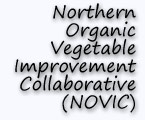 Carrot breeding is more complex because the farmer has to choose from root stock. Traditionally European farmers would choose from carrots they had stored in their root cellars over the winter. The carrots that were the most winter-hardy got planted in the spring, and, consequently, the carrot that came to the New World was broad-shouldered, dense, and very orange with a real “carroty” taste. More recent varieties have been selected for crunch and sweetness because they don’t have to overwinter.
Carrot breeding is more complex because the farmer has to choose from root stock. Traditionally European farmers would choose from carrots they had stored in their root cellars over the winter. The carrots that were the most winter-hardy got planted in the spring, and, consequently, the carrot that came to the New World was broad-shouldered, dense, and very orange with a real “carroty” taste. More recent varieties have been selected for crunch and sweetness because they don’t have to overwinter.
Nash grows about half of the farm’s carrot seed. His ideal carrot would hold up to freeze/thaw cycles, keep fungi at bay, and be sweet but still retain a true carrot flavor. It also has to have a large top to shade out chickweed, which can get out of hand on an organic farm in the winter, and a sturdy top to stand up to mechanical harvesting.
Carrots are a biennial crop, requiring two growing seasons to get through the life cycle and make new seed. They need to "vernalize" or go through a cold season (below 50 degrees F) in order to set seed. The carrots that Nash selects for seed are pulled up in February, then replanted later in the spring, where they set seed for future harvests.
Other seed breeding projects at Nash’s include spinach, overwintering cauliflower, and cabbage. There are no open pollinated varieties of cabbage available in the U.S., but there are still some in Europe. American farmers will have to reconstruct O.P. cabbage in this country.
Over 2013 and 2014, we will be documenting as many steps in our carrot program that we can—everything from planting, cultivating, harvesting and marketing to selecting carrots to take to seed—and putting some of the steps in the process up on YouTube. See the links below for what we have so far.
Cultivating carrots with finger wheels

 The NOVIC project partners researchers and organic farmers in the northern states of the U.S. to address farmers’ seed and plant breeding needs. The collaboration includes Oregon State University, University of Wisconsin, Cornell University, Washington State University, Organic Seed Alliance (OSA), and the USDA. The participants are working to:
The NOVIC project partners researchers and organic farmers in the northern states of the U.S. to address farmers’ seed and plant breeding needs. The collaboration includes Oregon State University, University of Wisconsin, Cornell University, Washington State University, Organic Seed Alliance (OSA), and the USDA. The participants are working to:
| * | Breed new crops for organic agriculture in the climatic conditions of the northern states |
| * | Identify best varieties for organic farms |
| * | Cultivate farmer/breeder partnerships |
| * | Educate the public on organic seeds, variety trials, and on-farm plant breeding |
Nash's Organic Produce is a participating farm for the Collaborative in Washington State. It is currently conducting vegetable variety trials on the farm on specific crops: broccoli, carrots, snap peas, sweet corn, and winter squash. Participants in Washington have also chosen to work on beets as a specific regional crop.
The focus is on winter crops and the goal is to enable organic farmers to extend their growing seasons, develop seed choices that will respond well to organic conditions during cold and wet seasons, find varieties that can withstand lower temperatures even in the field, and increase the window of availability for local food. All breeding is conducted under organic conditions. Results and skills are shared with other farmers, researchers and industry professionals at regional field days and workshops as a way of sharing information and teaching farmers how to do their own trials. Guides on seed production, plant variety improvement and breeding are published on OSA's website.
their growing seasons, develop seed choices that will respond well to organic conditions during cold and wet seasons, find varieties that can withstand lower temperatures even in the field, and increase the window of availability for local food. All breeding is conducted under organic conditions. Results and skills are shared with other farmers, researchers and industry professionals at regional field days and workshops as a way of sharing information and teaching farmers how to do their own trials. Guides on seed production, plant variety improvement and breeding are published on OSA's website.
On November 1, 2010, Nash's hosted a Field Day, focused entirely on carrots and beets. The farm has been working on a regular basis with OSA on many seed projects. OSA works directly with farmers to find or breed seed to local climates and conditions, and trains them to conduct their own trials on their own farms. They also provide the background in genetics.
"Breed under the conditions of intended use," advises Dr. John Navazio, Senior Scientist, Research & Education, and Seed Extension Specialist OSA/WSU. In Nash’s case, it means breeding for organic conditions in the unique Sequim climate. Nash Huber and the crew work closely with OSA to find or breed varieties that will enable them to extend their growing season.



